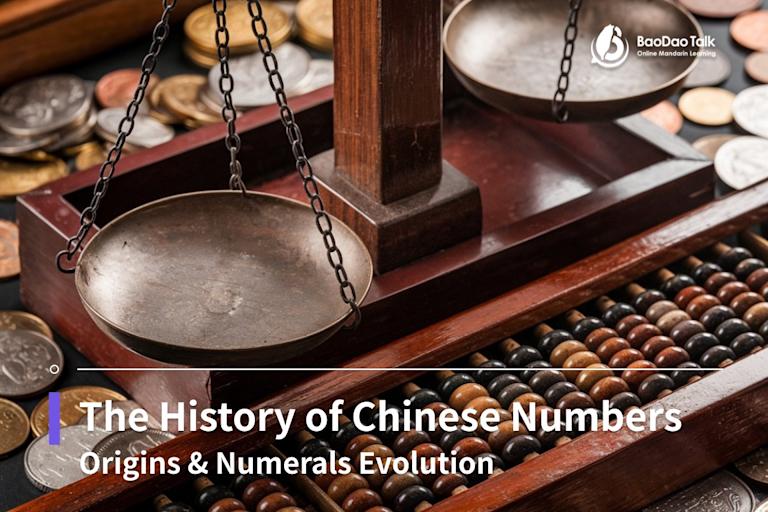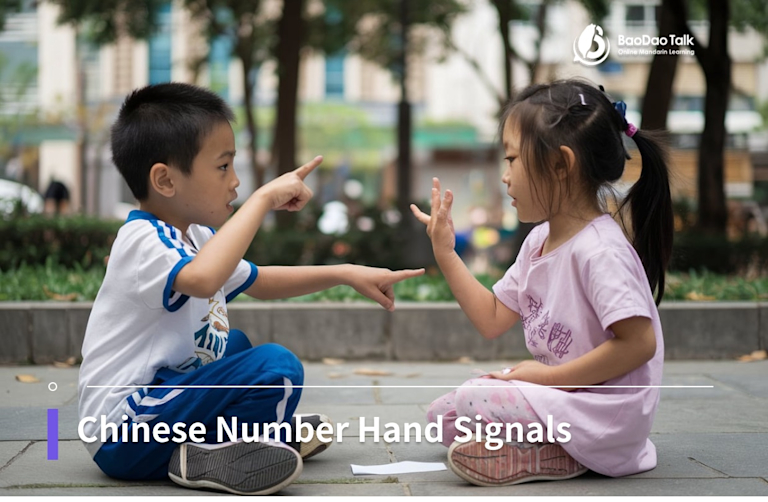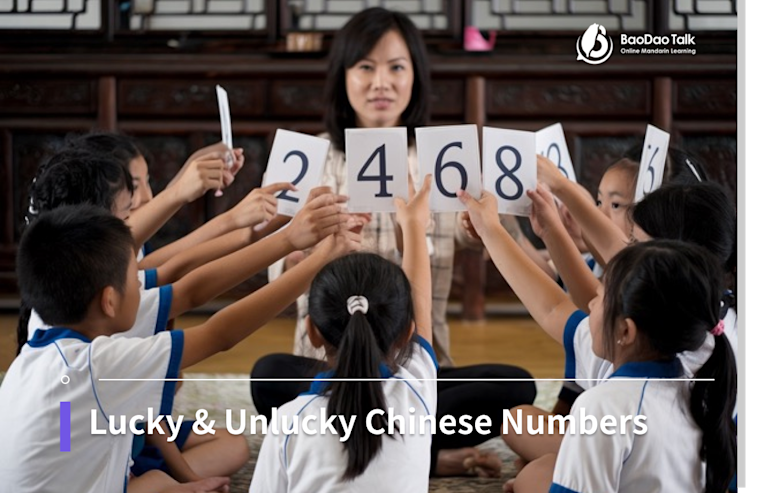BaoDao Talk Blog
2025-03-17updated
Counting Chinese Numbers 1-10: Learn Mandarin Numbers Easily

# Learning Mandarin
Master Chinese numbers 1-10 with pronunciation, characters, and cultural insights. Learn to count in Mandarin and explore number-related daily uses!
Quick Navigation
- How to Count from 1 to 10 in Mandarin Chinese
- Counting 11-99 in Chinese
- Chinese Numbers in Hundreds and Thousands
- Counting Beyond 10,000 in Chinese
- Using Chinese Numbers in Daily Life
- Fun Facts About Chinese Numbers
- Lucky & Unlucky Chinese Numbers
- Different Characters for Chinese Numbers
- Chinese Number 1 as 一幺 (yāo)
- Chinese Number 2 as 兩 (liǎng)
- Romantic Slangs with Chinese Numbers
- Learn More About Chinese Numbers with BaoDao Talk
Learning numbers in Chinese is essential for daily activities like shopping, telling time, and understanding idioms. Mastering numbers 1 to 10 in the Mandarin language provides a solid foundation for language learning, as Chinese number grammar is logical and easy to grasp. This foundational knowledge helps learners become more familiar with Mandarin, making it easier to progress in the language. Incorporate resources like pronunciation guides to aid in learning.
How to Count from 1 to 10 in Mandarin Chinese
Learning to count numbers from 1 to 10 in Mandarin language is relatively easy because each number has only one syllable, making them simple to remember. Including the number 0 is also essential, as it forms the basis for understanding larger numbers.

Here's a table showcasing the Chinese characters for numbers 1 to 10 and zero:
| Number | Chinese Character | Pinyin |
|---|---|---|
| 0 | 零 / 〇 | líng |
| 1 | 一 | yī |
| 2 | 二 | èr |
| 3 | 三 | sān |
| 4 | 四 | sì |
| 5 | 五 | wǔ |
| 6 | 六 | liù |
| 7 | 七 | qī |
| 8 | 八 | bā |
| 9 | 九 | jiǔ |
| 10 | 十 | shí |
Note that zero has two forms: 零 and 〇 (líng). In practice, "〇" is often seen in newspapers, magazines, page numbers, and phone numbers. Also, in the legal texts of Taiwan, where "零" is the standard form, and "〇" is used exclusively for numbering or dates.
Counting 11-99 in Chinese
Counting from 11 to 99 in Chinese involves straightforward rules. Here’s a breakdown of the grammar rules:
11-19:
- Combine 十 (shí, meaning ten) with the units (1-9).
- Example: 11 is 十一 (shí yī), 12 is 十二 (shí èr). 20-99: Combine the tens place (2-9) with 十 (shí) and the units (0-9). Example: 20 is 二十 (èr shí), 21 is 二十一 (èr shí yī), 99 is 九十九 (jiǔ shí jiǔ).
| Number | Chinese Character | Pinyin |
|---|---|---|
| 11 | 十一 | shí yī |
| 12 | 十二 | shí èr |
| 20 | 二十 | èr shí |
| 21 | 二十一 | èr shí yī |
| 30 | 三十 | sān shí |
| 35 | 三十五 | sān shí wǔ |
| 40 | 四十 | sì shí |
| 42 | 四十二 | sì shí èr |
| 50 | 五十 | wǔ shí |
| 58 | 五十八 | wǔ shí bā |
| 60 | 六十 | liù shí |
| 64 | 六十四 | liù shí sì |
| 70 | 七十 | qī shí |
| 73 | 七十三 | qī shí sān |
| 80 | 八十 | bā shí |
| 86 | 八十六 | bā shí liù |
| 90 | 九十 | jiǔ shí |
| 99 | 九十九 | jiǔ shí jiǔ |
Chinese Numbers in Hundreds and Thousands
The basic units are 百 (bǎi) for hundred and 千 (qiān) for thousand, with the structure being straightforward and similar to English. Numbers are formed by stating the digit followed by the unit.
For instance, 100 is 一百 (yī bǎi), 200 is 二百 (èr bǎi), and 900 is 九百 (jiǔ bǎi). For thousands, 1,000 is 一千 (yī qiān), 2,000 is 二千 (èr qiān), and 9,000 is 九千 (jiǔ qiān). In Taiwan, it's more common to use 兩 (liǎng) instead of 二 (èr) when counting numbers over a hundred. For example, you would say 兩百 (liǎng bǎi) instead of 二百 (èr bǎi). The same rule applies to thousands and higher numbers.
Zero (零, líng) is used as a placeholder between significant digits for clarity, such as in 101, which is 一百零一 (yī bǎi líng yī). Also, 十 (10) by itself is written as 十, but when it appears within a larger number, it should be written as 一十 (yī shí) to avoid confusion. So, in 110, which needs to be read as 一百一十 (yī bǎi yī shí) or 一百一 (yī bǎi yī) in colloquial speech. Finally, the number "100" is typically written as "一百" or "一〇〇" in some cases, but rarely as "一零零".
| English Number | Chinese Number | Pinyin |
|---|---|---|
| 100 | 一百 | yī bǎi |
| 101 | 一百零一 | yī bǎi líng yī |
| 110 | 一百一十 | yī bǎi yī shí |
| 200 | 二百/兩百 | èr bǎi/liǎng bǎi |
| 1,000 | 一千 | yī qiān |
| 1,001 | 一千零一 | yī qiān líng yī |
Counting Beyond 10,000 in Chinese
In Chinese, numbers are grouped by units of ten thousand. For example, ten thousand (10,000) is written as 一萬 (yī wàn), and one hundred thousand (100,000) is written as 十萬 (shí wàn), meaning "ten ten-thousands." One million (1,000,000) is written as 一百萬 (yī bǎi wàn), translating to "one hundred ten-thousands." When numbers reach one hundred million (100,000,000), the character 億 (yì) is used.
The number zero (零) plays a crucial role in maintaining clarity, similar to its use in numbers from one hundred onward. Zero should always appear between two significant digits. Also, the rule for 一十 (yī shí) is the same.
| English Number | Chinese Number | Pinyin |
|---|---|---|
| 10,000 | 一萬 | yí wàn |
| 10,001 | 一萬零一 | yí wàn líng yī |
| 10,010 | 一萬零一十 | yí wàn líng yī shí |
| 10,100 | 一萬零一百 | yí wàn líng yì bǎi |
| 100,000 | 十萬 | shí wàn |
| 100,001 | 十萬零一 | shí wàn líng yī |
| 1,000,000 | 一百萬 | yì bǎi wàn |
| 10,000,000 | 一千萬 | yì qiān wàn |
| 100,000,000 | 一億 | yí yì |
| 1,000,000,000 | 十億 | shí yì |
Using Chinese Numbers in Daily Life
After mastering the basics of Chinese numbers, it’s time to apply your knowledge to real-world situations. Learning how to read prices, express time, and handle everyday situations will help you integrate Chinese numbers into your daily life seamlessly.
Reading Prices in Chinese
In Chinese, prices are expressed using specific measurement units:
- 元/塊 (yuán/kuài): The basic unit, similar to the dollar. 元 is used in formal contexts, while 塊 is used colloquially.
- 角/毛 (jiǎo/máo): This unit represents a tenth of a yuan, similar to a dime. 角 is used in formal contexts, while 毛 is used colloquially.
- 分 (fēn): This unit represents a hundredth of a yuan, similar to a cent.
Examples in RMB (Chinese Yuan)
- ¥4.10 - 四元一角 (sì yuán yī jiǎo) or 四塊一 (sì kuài yī)
- ¥10.75 - 十元七角五分 (shí yuán qī jiǎo wǔ fēn) or 十塊七毛五 (shí kuài qī máo wǔ)
- ¥99.99 - 九十九元九角九分 (jiǔshíjiǔ yuán jiǔ jiǎo jiǔ fēn) or 九十九塊九毛九 (jiǔshíjiǔ kuài jiǔ máo jiǔ)
Examples in NTD (New Taiwan Dollar)
- NT$45 - 四十五元 (sìshíwǔ yuán) or 四十五塊 (sì kuài)
Note that there is no 角/毛/分 (jiǎo/máo/fēn) for NTD.
Expressing Time in Chinese
In Chinese, time is expressed using specific measurement units such as 小時 (xiǎoshí) for hours, 分鐘 (fēnzhōng) for minutes, and 秒 (miǎo) for seconds. Here are the basic rules and examples for expressing time:
- Hours: The word for an hour is 小時 (xiǎoshí) or 鐘頭 (zhōngtóu), and 點 (diǎn) is used for "o'clock."
- Minutes: Minutes can be expressed with 分 (fēn) or 分鐘 (fēnzhōng).
- Seconds: Seconds are expressed with 秒 (miǎo).
Example: 7:05:30 is 七點零五分三十秒 (qī diǎn líng wǔ fēn sān shí miǎo).
Fun Facts About Chinese Numbers
Chinese numbers are filled with fascinating cultural significance and unique practices. Here are some fun facts and insights about them.
Lucky & Unlucky Chinese Numbers
In Chinese culture, certain numbers are considered lucky or unlucky symbols based on their pronunciation and cultural associations.
Lucky Numbers
- 8 (八, bā): This is the luckiest number because it sounds like "發" (fā), which means wealth or fortune. It's commonly associated with prosperity and success. People often pay extra to have this number in phone numbers, addresses, or license plates.
- 6 (六, liù): This number in Chinese sounds like "流" (liú), which means smooth or flowing, implying that things will go smoothly. The idiom “六六大順” (liù liù dà shùn) is used to wish someone great success and smooth progress in their endeavors, symbolizing blessings for a prosperous and trouble-free journey.
- 9 (九, jiǔ): This number sounds like "久" (jiǔ), meaning long-lasting, and is associated with longevity and eternal life. It is also a symbol of completeness and eternity.
- 2 (二, èr): This number signifies harmony and balance, often associated with the saying "好事成雙" (hǎo shì chéng shuāng), meaning "good things come in pairs." It is also seen as a number of cooperation and partnership.
Unlucky Numbers
4 (四, sì): This is the unluckiest number because it sounds like "死" (sǐ), which means death. Due to this negative association, buildings, especially hospitals, may skip the fourth floor, replacing it with "3A" or other variations. This is similar to how the number 13 is avoided in Western cultures.
Cultural Practices
Chinese people usually prefer giving gifts in even numbers (except for the number 4), as even numbers are considered more auspicious and represent harmony and balance. For example, at weddings, it is customary to give red envelopes (紅包, hóngbāo) with amounts in even numbers, such as 2,600 or 3,600 in Taiwan.
Conversely, offerings for Chinese prayers are often made in odd numbers, as they are believed to be more spiritually significant. For example, for offerings during the Zhongyuan Festival , three types of meat (三牲, sāngshēng) are traditionally prepared. If fruits are included, the variety should be in odd numbers, such as 1, 3, or 5.
Different Characters for Chinese Numbers
Most Chinese numbers have distinct characters for financial and mathematical applications to prevent fraud and manipulation. This system employs complex characters to make altering numerical values in documents difficult.
For instance, the financial character for one is 壹 (yī), compared to the regular 一 (yī). Similarly, two is written as 貳 (èr) in financial contexts instead of 二 (èr), and three is 參 (sān) rather than 三 (sān).
The main reason is that these characters for each number are significantly different in shape, making alterations challenging and preventing tampering. This practice originated in the Tang Dynasty and became standardized and enforced during the Ming Dynasty since this period was rife with corruption cases.
Here are the complete financial and standard characters for Mandarin numbers 1 to 10:
| Number | Financial Character | Standard Character | Pinyin |
|---|---|---|---|
| 1 | 壹 | 一 | yī |
| 2 | 貳 | 二 | èr |
| 3 | 參 | 三 | sān |
| 4 | 肆 | 四 | sì |
| 5 | 伍 | 五 | wǔ |
| 6 | 陸 | 六 | liù |
| 7 | 柒 | 七 | qī |
| 8 | 捌 | 八 | bā |
| 9 | 玖 | 九 | jiǔ |
| 10 | 拾 | 十 | shí |
Let’s look at a real example. Let’s say you are going to a bank to write the number 15,689 for a transaction, you would use the financial characters to ensure the amount is secure and not easily altered. Here’s how you would write it:
15,689: 壹萬伍仟陸佰捌拾玖 (yī wàn wǔ qiān liù bǎi bā shí jiǔ)
Start with 壹 (yī) for 1, followed by 萬 (wàn) to indicate 10,000. Then, add 伍 (wǔ) for 5, 仟 (qiān) for 1,000, 陸 (liù) for 6, 佰 (bǎi) for 100, 捌 (bā) for 8, 拾 (shí) for 10, and finally 玖 (jiǔ) for 9.
Chinese Number 1 as 一幺 (yāo)
The number "one" (一, yī) is often pronounced as "yāo" (幺) instead of "yī" in specific contexts to avoid confusion with the number seven (七, qī), which sounds similar, especially over the phone or in rapid speech in Mandarin. This practice is particularly common when reciting phone numbers, area codes, or any sequence of digits where clarity is crucial.
For example, if you need to dial the emergency number 119, you would say "yāo yāo jiǔ" instead of "yī yī jiǔ" to prevent confusion with the number seven. This usage is prevalent in China to ensure clarity in communication, especially in emergencies where mishearing could have serious consequences.
In Taiwan, however, people generally use the standard pronunciation "yī" even in these contexts. Despite this, the pronunciation "yāo" remains common in the military to avoid any potential confusion when reciting numbers or codes.
Chinese Number 2 as 兩 (liǎng)
The number two in Mandarin can be written as either 二 (èr) or 兩 (liǎng), and their usage depends on the context. Generally, 二 (èr) is used for counting, ordinal numbers, and in mathematical contexts.
For example, 二 is used in sequences like 一, 二, 三 (one, two, three), and in mathematical expressions like 1/2 (二分之一, èr fēn zhī yī). It is also used for ordinal numbers like 第二 (dì èr), meaning second, or in formal settings, such as 二樓 (èr lóu) for the second floor.
Conversely, 兩 (liǎng) is used when specifying quantities with measure words, which helps provide clarity in spoken and written Chinese. For example, it is used in phrases like �兩本書 (liǎng běn shū, two books), and 兩輛車 (liǎng liàng chē, two cars).
Moreover, it is commonly used for larger units in spoken Chinese in Taiwan, such as 兩千 (liǎng qiān) for two thousand. It is also used to express approximate quantities, such as 兩三百塊錢 (liǎng sān bǎi kuài qián) for two or three hundred.
Finally, for describing time, use 兩 (liǎng). For example, 2:15 is 兩點十五分 (liǎng diǎn shíwǔ fēn).
Romantic Slangs with Chinese Numbers
In Mandarin Chinese, certain number sequences carry romantic meanings due to their phonetic similarities to phrases expressing love and affection. Here are some common examples:
- 520 (wǔ èr líng): This sequence sounds like "我愛你" (wǒ ài nǐ), which means "I love you."
- 1314 (yī sān yī sì): This sequence sounds like "一生一世" (yī shēng yī shì), which means "forever" or "for a lifetime."
These number sequences are commonly used in texts, on special occasions like Valentine's Day, and even in daily conversations to express affection creatively and memorably.
Learn More About Chinese Numbers with BaoDao Talk
Learning to count from 1 to 10 in Mandarin Chinese is an essential foundation for anyone beginning their language journey. Each of these characters is fundamental not only for counting but also for understanding larger numbers and other important aspects of the Mandarin language. By mastering these basics, learners can build a strong foundation for more complex language skills, such as learning Chinese idioms.
If you want to elevate your Mandarin skills and immerse yourself in Taiwanese culture, BaoDao Talk is the perfect platform. We offer interactive learning experiences, structured courses tailored to your pace, and qualified native-speaking tutors. BaoDao Talk provides immersive cultural learning with features like stroke order animation demos, quiz modes, and personalized support. Visit BaoDao Talk now and unlock your language-learning potential!
Read More:
- Decode Top 38 Chinese Symbols with Meanings & Cultural Importance - BaoDao Talk
- 14 Chinese Festivals: How They’re Celebrated Traditionally - BaoDao Talk
- 35+ Famous Chinese Idioms to Learn with Study Tips - BaoDao Talk
- Chinese Number Hand Signals and Counting: Complete Guide
- The Chinese Abacus Explained: Counting, Multiplication & More - BaoDao Talk
- Chinese Lucky & Unlucky Numbers: the Cultural Impact Explained
Share to:









